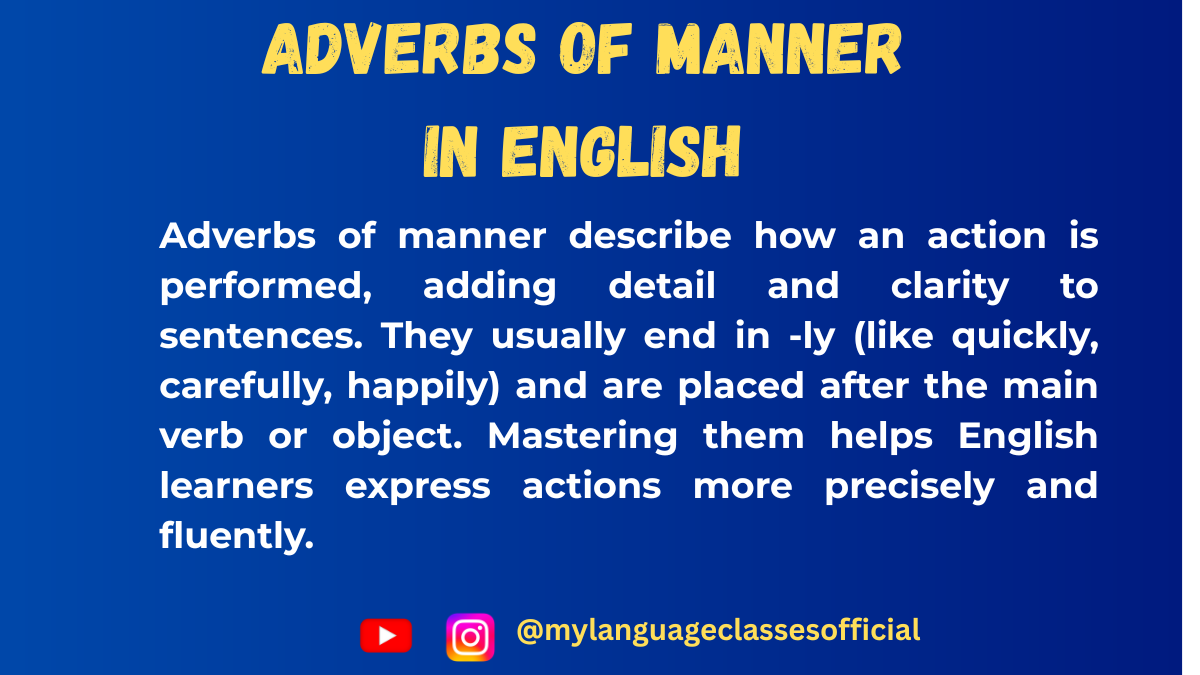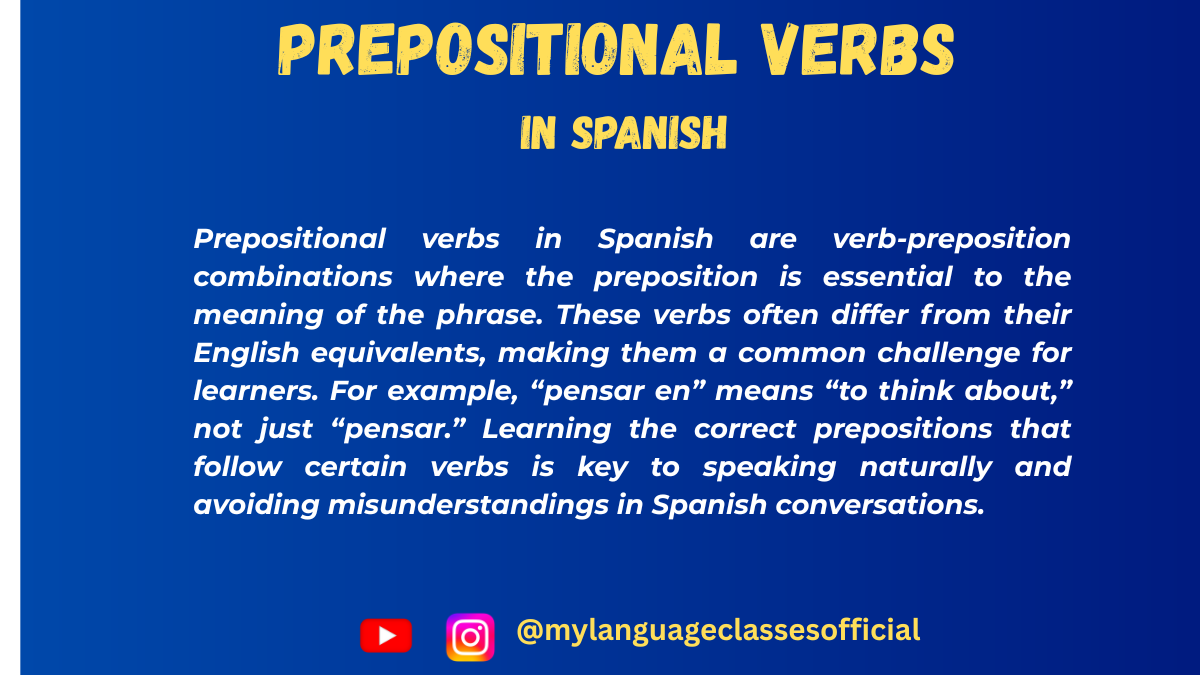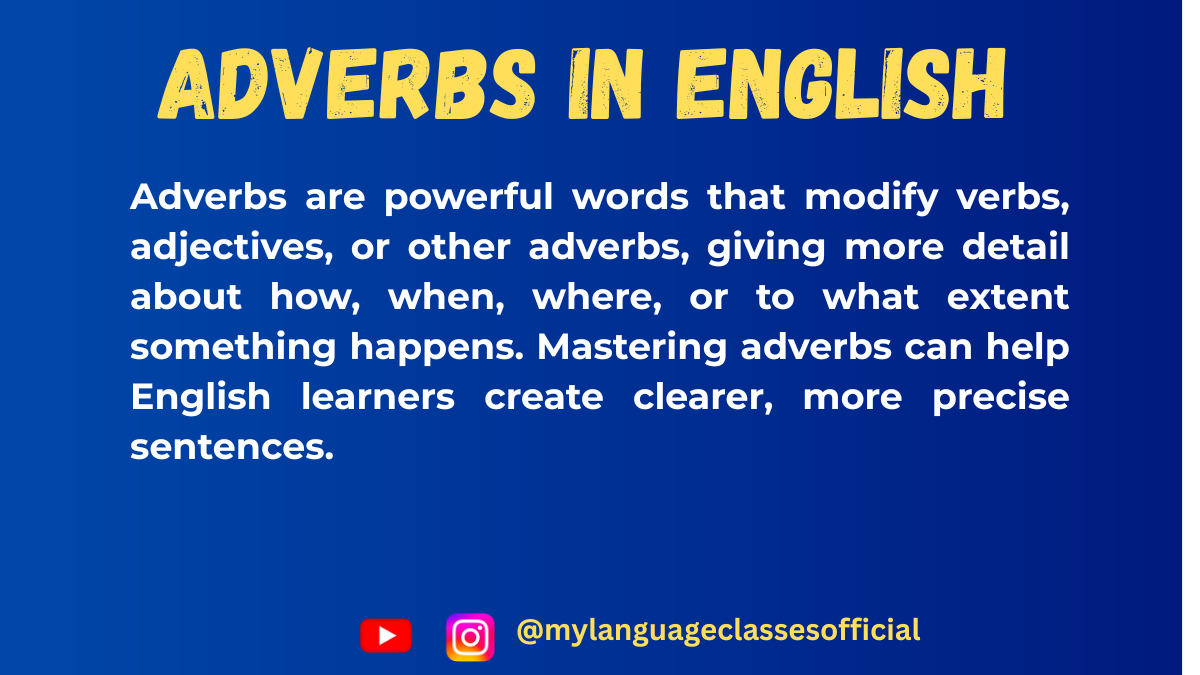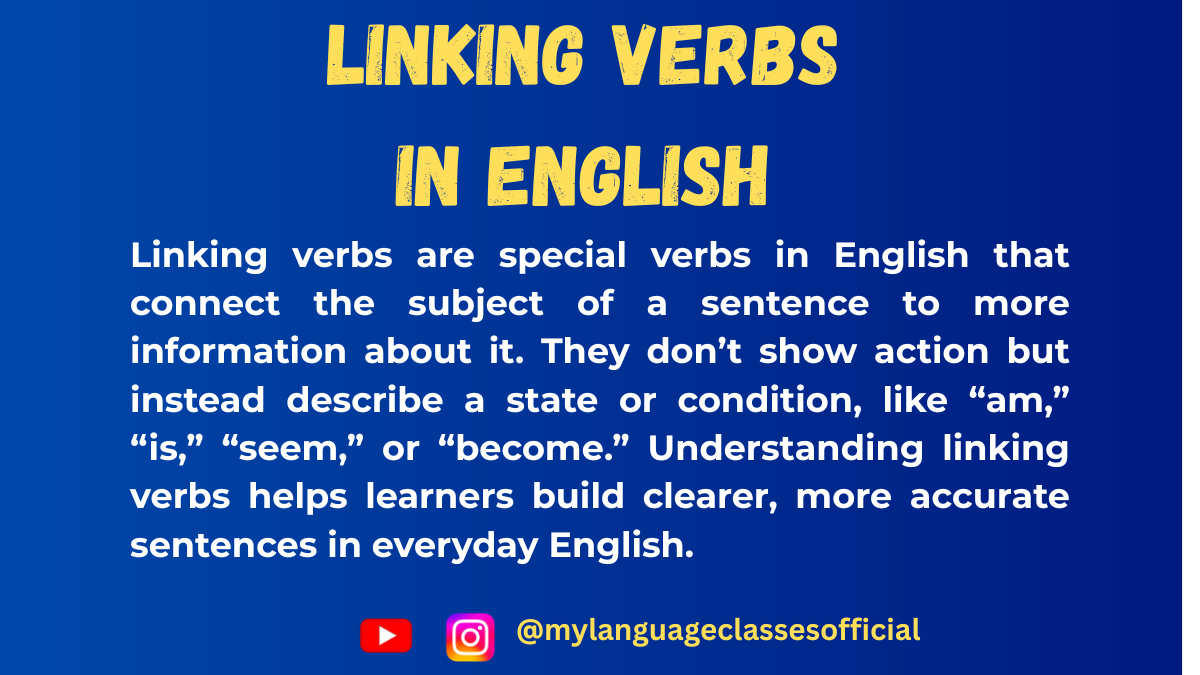Your cart is currently empty!
Tag: daily prompt
-
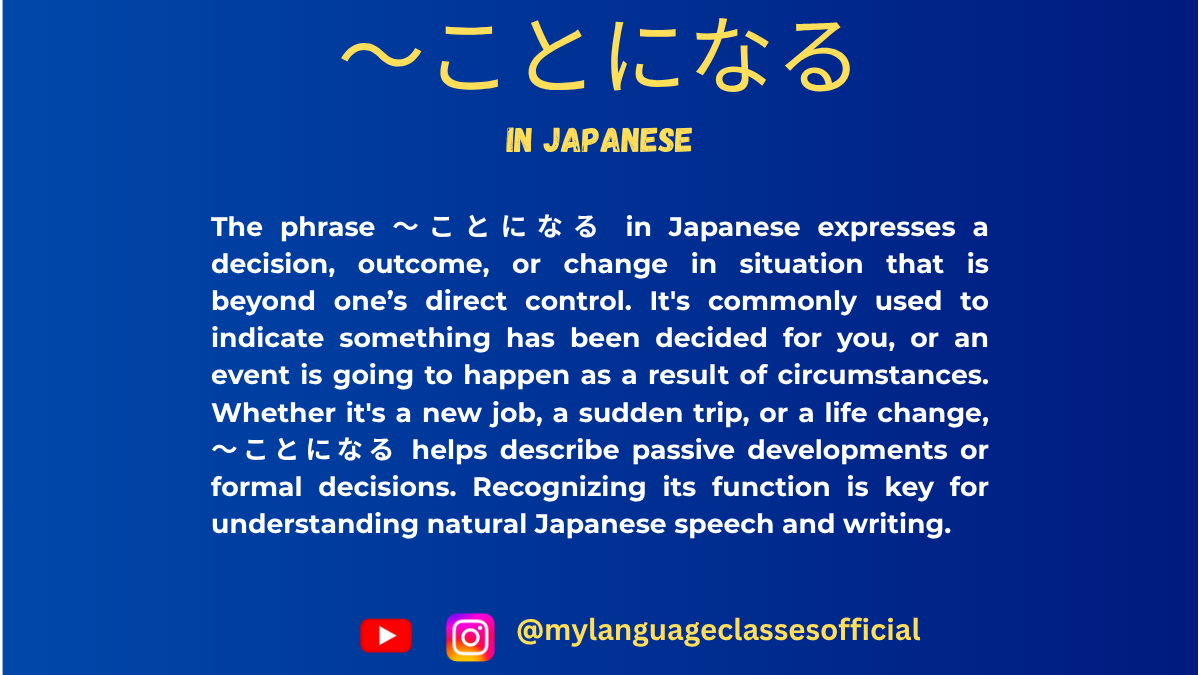
Understanding 〜ことになる in Japanese | My Language Classes
Understanding 〜ことになる
If you’re learning Japanese, you’ve likely come across the phrase 〜ことになる (koto ni naru). This grammatical structure is incredibly versatile and is used in various contexts to express outcomes, decisions, or natural conclusions. Whether you’re a beginner or an advanced learner, mastering 〜ことになる will significantly enhance your Japanese communication skills.
In this blog post, we’ll break down everything you need to know about 〜ことになる, including its formation, usage, and examples. Let’s dive in!
What Does 〜ことになる Mean?
The phrase 〜ことになる is used to indicate that something has been decided, arranged, or naturally resulted in a certain outcome. It often implies that the decision or outcome is beyond the speaker’s control or is a result of external circumstances. Think of it as expressing “it has been decided that…” or “it turns out that…” in English.
For example:
- 日本に留学することになりました。
(Nihon ni ryuugaku suru koto ni narimashita.)
It has been decided that I will study abroad in Japan.
This sentence suggests that the decision to study abroad was made, possibly by someone else or due to circumstances, rather than the speaker actively choosing it.
Formation of 〜ことになる
The formation of 〜ことになる depends on the type of word it follows: verbs, nouns, or adjectives. Here’s how it works:
1. With Verbs
- Verb (dictionary form) + ことになる
Example:- 行く (iku) → 行くことになる (iku koto ni naru)
- 食べる (taberu) → 食べることになる (taberu koto ni naru)
2. With Nouns
- Noun + になる
Example:- 先生 (sensei) → 先生になる (sensei ni naru)
- 休み (yasumi) → 休みになる (yasumi ni naru)
3. With Adjectives
- い-Adjective (remove い) + くなる
Example:- 高い (takai) → 高くなる (takaku naru)
- 楽しい (tanoshii) → 楽しくなる (tanoshiku naru)
- な-Adjective + になる
Example:- 静か (shizuka) → 静かになる (shizuka ni naru)
- 元気 (genki) → 元気になる (genki ni naru)
Usage of 〜ことになる
〜ことになる is used in various situations to express decisions, outcomes, or natural conclusions. Here are some common scenarios:
- Decisions Made by Others
- When someone else makes a decision that affects you.
Example: 来月転勤することになりました。
(Raigetsu tenkin suru koto ni narimashita.)
It has been decided that I will be transferred next month.
- When someone else makes a decision that affects you.
- Natural Outcomes
- When something happens as a natural result.
Example: 雨が降ったので、試合は中止することになりました。
(Ame ga futta node, shiai wa chuushi suru koto ni narimashita.)
Because it rained, the match has been canceled.
- When something happens as a natural result.
- Future Plans
- When talking about future plans or arrangements.
Example: 来週の会議は延期することになりました。
(Raishuu no kaigi wa enki suru koto ni narimashita.)
It has been decided that next week’s meeting will be postponed.
- When talking about future plans or arrangements.
- Unavoidable Situations
- When something is unavoidable or inevitable.
Example: 彼は仕事を辞めることになりました。
(Kare wa shigoto o yameru koto ni narimashita.)
He ended up quitting his job.
- When something is unavoidable or inevitable.
List of Verbs, Nouns, and Adjectives with 〜ことになる
Here’s a table with examples of verbs, nouns, and adjectives in their 〜ことになる form:
Type Word 〜ことになる Form Example Sentence (Romaji) Meaning in English Verb 行く (iku) 行くことになる 来月日本に行くことになりました。 It has been decided that I will go to Japan next month. 食べる (taberu) 食べることになる 彼は野菜しか食べないことになりました。 It has been decided that he will only eat vegetables. Noun 先生 (sensei) 先生になる 彼は来年先生になることになりました。 It has been decided that he will become a teacher next year. 休み (yasumi) 休みになる 明日は休みになることになりました。 It has been decided that tomorrow will be a day off. い-Adj 高い (takai) 高くなる 来月から家賃が高くなることになりました。 It has been decided that the rent will increase next month. 楽しい (tanoshii) 楽しくなる このイベントは楽しくなることになりました。 It has been decided that this event will be fun. な-Adj 静か (shizuka) 静かになる この部屋は静かになることになりました。 It has been decided that this room will be quiet. 元気 (genki) 元気になる 彼は手術後、元気になることになりました。 It has been decided that he will recover after the surgery.
More Example Sentences
Here are 10 more examples of 〜ことになる in action:
- 来週から新しいプロジェクトを始めることになりました。
(Raishuu kara atarashii purojekuto o hajimeru koto ni narimashita.)
It has been decided that I will start a new project next week. - 彼女は来月結婚することになりました。
(Kanojo wa raigetsu kekkon suru koto ni narimashita.)
It has been decided that she will get married next month. - この本は来年映画化することになりました。
(Kono hon wa rainen eiga-ka suru koto ni narimashita.)
It has been decided that this book will be adapted into a movie next year. - 来週のパーティーは中止することになりました。
(Raishuu no paatii wa chuushi suru koto ni narimashita.)
It has been decided that next week’s party will be canceled. - 彼は来年アメリカに引っ越すことになりました。
(Kare wa rainen Amerika ni hikkosu koto ni narimashita.)
It has been decided that he will move to America next year. - この商品は値上げすることになりました。
(Kono shouhin wa neage suru koto ni narimashita.)
It has been decided that this product will increase in price. - 来月から新しい制度が始まることになりました。
(Raigetsu kara atarashii seido ga hajimaru koto ni narimashita.)
It has been decided that a new system will start next month. - 彼は来週退院することになりました。
(Kare wa raishuu taiin suru koto ni narimashita.)
It has been decided that he will be discharged from the hospital next week. - この問題は解決することになりました。
(Kono mondai wa kaiketsu suru koto ni narimashita.)
It has been decided that this problem will be resolved. - 彼女は来年留学することになりました。
(Kanojo wa rainen ryuugaku suru koto ni narimashita.)
It has been decided that she will study abroad next year.
Things to Keep in Mind
- Politeness Level: 〜ことになる is neutral in tone. For formal situations, use 〜ことになります (koto ni narimasu) or 〜ことになりました (koto ni narimashita).
- Subject Implication: The subject of the sentence is often omitted in Japanese, so pay attention to context to understand who or what is being discussed.
- Natural Outcomes: 〜ことになる often implies that the outcome is natural or unavoidable, rather than a personal choice.
- Verb Tense: The verb before 〜ことになる is usually in the dictionary form, but the tense of the sentence depends on the context.
Fill in the Blanks
Test your understanding of 〜ことになる with these fill-in-the-blank questions:
- 来月、新しい仕事を______ことになりました。
(Raigetsu, atarashii shigoto o ______ koto ni narimashita.)
It has been decided that I will start a new job next month. - 彼は来年、大学を______ことになりました。
(Kare wa rainen, daigaku o ______ koto ni narimashita.)
It has been decided that he will graduate from university next year. - このイベントは______ことになりました。
(Kono ibento wa ______ koto ni narimashita.)
It has been decided that this event will be canceled. - 来週から、新しいルールが______ことになりました。
(Raishuu kara, atarashii ruuru ga ______ koto ni narimashita.)
It has been decided that a new rule will start next week. - 彼女は来月、______ことになりました。
(Kanojo wa raigetsu, ______ koto ni narimashita.)
It has been decided that she will get married next month. - この商品は______ことになりました。
(Kono shouhin wa ______ koto ni narimashita.)
It has been decided that this product will increase in price. - 彼は来年、______ことになりました。
(Kare wa rainen, ______ koto ni narimashita.)
It has been decided that he will move to America next year. - この問題は______ことになりました。
(Kono mondai wa ______ koto ni narimashita.)
It has been decided that this problem will be resolved. - 来週の会議は______ことになりました。
(Raishuu no kaigi wa ______ koto ni narimashita.)
It has been decided that next week’s meeting will be postponed. - 彼は手術後、______ことになりました。
(Kare wa shujutsu-go, ______ koto ni narimashita.)
It has been decided that he will recover after the surgery.
Answers:
- 始める (hajimeru)
- 卒業する (sotsugyou suru)
- 中止する (chuushi suru)
- 始まる (hajimaru)
- 結婚する (kekkon suru)
- 値上げする (neage suru)
- アメリカに引っ越す (Amerika ni hikkosu)
- 解決する (kaiketsu suru)
- 延期する (enki suru)
- 元気になる (genki ni naru)
Conclusion
Mastering 〜ことになる is a key step in becoming fluent in Japanese. This structure is essential for expressing decisions, outcomes, and natural conclusions in a variety of contexts. By understanding its formation and usage, you’ll be able to communicate more effectively and naturally in Japanese. Keep practicing with the examples and exercises provided, and soon you’ll be using 〜ことになる like a pro!
If you enjoyed this lesson, be sure to check out more posts like this on my blog at My Language Classes. Don’t forget to subscribe my YouTube channel and follow me on Instagram for the latest language learning tips and lessons. Leave a comment below to share your thoughts, or ask any questions you have about nouns.
Happy learning! 😊
- 日本に留学することになりました。
-
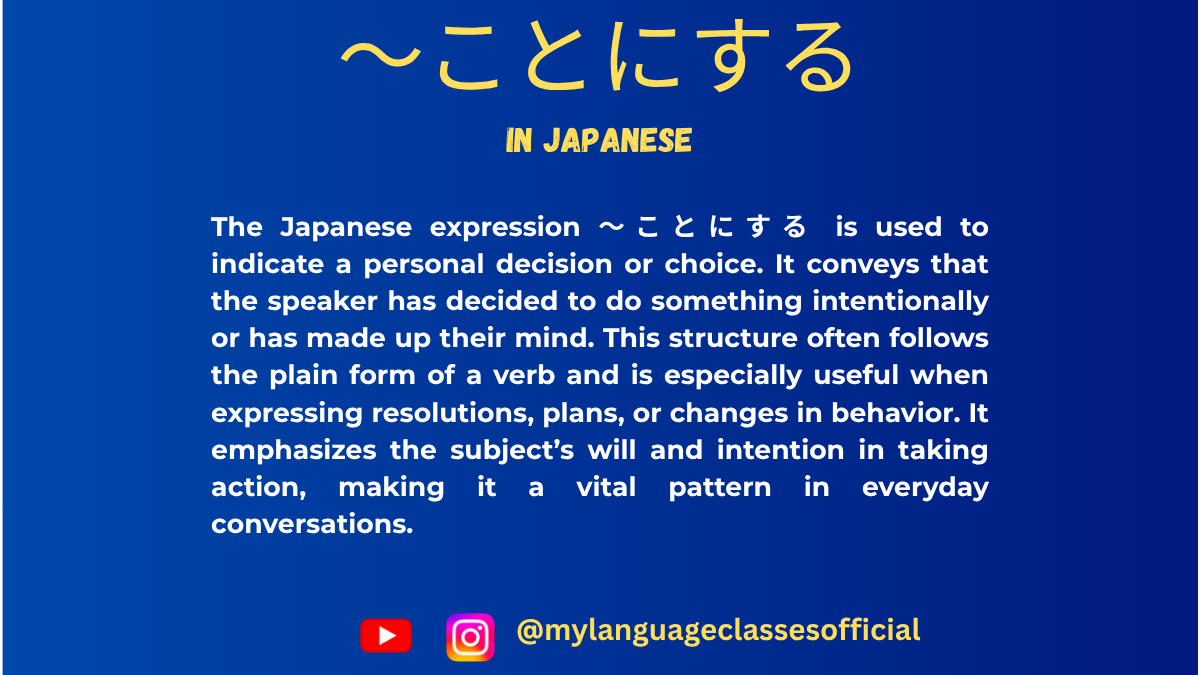
Mastering 〜ことにする in Japanese | My Language Classes
Using 〜ことにする in Japanese
When learning Japanese, one of the most useful grammar points you’ll encounter is 〜ことにする. This expression is essential for expressing decisions, resolutions, or choices in daily life. Whether you’re deciding to start a new habit, make a lifestyle change, or simply choose what to eat for dinner, 〜ことにする is your go-to structure.
In this blog post, we’ll dive deep into the meaning, formation, usage, and examples of 〜ことにする. By the end, you’ll be able to use it confidently in various situations!
What Does 〜ことにする Mean?
〜ことにする is a Japanese grammar structure used to express a decision or resolution made by the speaker. It translates to “decide to” or “make up one’s mind to” in English. It emphasizes that the decision is a conscious choice, often implying a sense of determination or commitment.
For example:
- 勉強することにしました。
Benkyou suru koto ni shimashita.
I decided to study.
This sentence shows that the speaker has made a deliberate decision to study.
Formation of 〜ことにする
The formation of 〜ことにする depends on the type of word it follows: verbs, nouns, or adjectives. Let’s break it down:
1. With Verbs
- Verb (dictionary form) + ことにする
Example:- 食べる (taberu) → 食べることにする (taberu koto ni suru)
- 行く (iku) → 行くことにする (iku koto ni suru)
2. With Nouns
- Noun + にする
Example:- 休み (yasumi) → 休みにする (yasumi ni suru)
- コーヒー (koohii) → コーヒーにする (koohii ni suru)
3. With Adjectives
- い-Adjective + く + する
Example:- 早い (hayai) → 早くすることにする (hayaku suru koto ni suru)
- な-Adjective + に + する
Example:- 簡単 (kantan) → 簡単にすることにする (kantan ni suru koto ni suru)
Usage of 〜ことにする
〜ことにする is used in various situations where a decision or resolution is made. Here are some common scenarios:
- Personal Resolutions: Deciding to start or stop a habit.
- 毎日運動することにしました。
Mainichi undou suru koto ni shimashita.
I decided to exercise every day.
- 毎日運動することにしました。
- Choosing Between Options: Making a choice between alternatives.
- 今日はパスタを食べることにする。
Kyou wa pasuta o taberu koto ni suru.
I’ll decide to eat pasta today.
- 今日はパスタを食べることにする。
- Future Plans: Deciding on future actions.
- 来週、旅行に行くことにする。
Raishuu, ryokou ni iku koto ni suru.
I’ve decided to go on a trip next week.
- 来週、旅行に行くことにする。
- Changes in Plans: Altering previous decisions.
- やめることにしました。
Yameru koto ni shimashita.
I’ve decided to quit.
- やめることにしました。
- Expressing Intentions: Showing determination or commitment.
- 頑張ることにする!
Ganbaru koto ni suru!
I’ll decide to do my best!
- 頑張ることにする!
List of Verbs, Nouns, and Adjectives with 〜ことにする
Here’s a table with examples of verbs, nouns, and adjectives in their 〜ことにする form:
Word Type 〜ことにする Form Example Sentence Romaji English Meaning 食べる (taberu) Verb 食べることにする 今日は野菜を食べることにする。 Kyou wa yasai o taberu koto ni suru. I’ll decide to eat vegetables today. 行く (iku) Verb 行くことにする 明日、公園に行くことにする。 Ashita, kouen ni iku koto ni suru. I’ll decide to go to the park tomorrow. 休み (yasumi) Noun 休みにする 今日は休みにする。 Kyou wa yasumi ni suru. I’ll decide to take a break today. コーヒー (koohii) Noun コーヒーにする 朝はコーヒーにする。 Asa wa koohii ni suru. I’ll decide to have coffee in the morning. 早い (hayai) い-Adjective 早くすることにする 毎日早く起きることにする。 Mainichi hayaku okiru koto ni suru. I’ll decide to wake up early every day. 簡単 (kantan) な-Adjective 簡単にすることにする この問題を簡単にすることにする。 Kono mondai o kantan ni suru koto ni suru. I’ll decide to make this problem simple.
More Example Sentences
Here are 10 additional examples to help you understand 〜ことにする better:
- 毎日日本語を勉強することにしました。
Mainichi nihongo o benkyou suru koto ni shimashita.
I decided to study Japanese every day. - 今夜は早く寝ることにする。
Konya wa hayaku neru koto ni suru.
I’ll decide to go to bed early tonight. - 来月からジムに通うことにする。
Raigetsu kara jimu ni kayou koto ni suru.
I’ve decided to go to the gym starting next month. - 甘いものを控えることにしました。
Amai mono o hikaeru koto ni shimashita.
I decided to cut back on sweets. - 今日は映画を見ることにする。
Kyou wa eiga o miru koto ni suru.
I’ll decide to watch a movie today. - 週末は家でゆっくりすることにする。
Shuumatsu wa ie de yukkuri suru koto ni suru.
I’ll decide to relax at home this weekend. - 新しい仕事を探すことにしました。
Atarashii shigoto o sagasu koto ni shimashita.
I decided to look for a new job. - 毎日歩くことにする。
Mainichi aruku koto ni suru.
I’ll decide to walk every day. - 今日はお酒を飲まないことにする。
Kyou wa osake o nomanai koto ni suru.
I’ll decide not to drink alcohol today. - この本を読むことにする。
Kono hon o yomu koto ni suru.
I’ll decide to read this book.
Things to Keep in Mind
- Politeness Level: 〜ことにする is neutral in tone. For formal situations, use 〜ことにします or 〜ことにしました.
- Negative Form: To express a decision not to do something, use 〜ないことにする.
Example: 食べないことにする (tabenai koto ni suru) – I’ll decide not to eat. - Past Tense: Use 〜ことにした to indicate a decision made in the past.
Example: 行くことにした (iku koto ni shita) – I decided to go. - Context Matters: The context of the sentence will determine whether the decision is about the future, present, or past.
Fill in the Blanks
Test your understanding with these fill-in-the-blank questions!
- 今日は勉強する______。
Kyou wa benkyou suru ______.
(I’ll decide to study today.) - 来週、旅行に______。
Raishuu, ryokou ni ______.
(I’ve decided to go on a trip next week.) - 毎日運動する______。
Mainichi undou suru ______.
(I decided to exercise every day.) - 今日はコーヒー______。
Kyou wa koohii ______.
(I’ll decide to have coffee today.) - 甘いものを控える______。
Amai mono o hikaeru ______.
(I decided to cut back on sweets.) - 今夜は早く______。
Konya wa hayaku ______.
(I’ll decide to go to bed early tonight.) - 新しい仕事を探す______。
Atarashii shigoto o sagasu ______.
(I decided to look for a new job.) - 週末は家でゆっくり______。
Shuumatsu wa ie de yukkuri ______.
(I’ll decide to relax at home this weekend.) - この本を読む______。
Kono hon o yomu ______.
(I’ll decide to read this book.) - 毎日歩く______。
Mainichi aruku ______.
(I’ll decide to walk every day.)
Answers:
- ことにする
- 行くことにする
- ことにしました
- にする
- ことにしました
- 寝ることにする
- ことにしました
- することにする
- ことにする
- ことにする
Conclusion
Mastering 〜ことにする is a game-changer for expressing decisions and resolutions in Japanese. Whether you’re making a personal commitment, choosing between options, or altering plans, this grammar point is versatile and practical. By practicing the examples and understanding the formation rules, you’ll be able to use 〜ことにする confidently in conversations and writing. Keep practicing, and soon it’ll become second nature!
If you enjoyed this lesson, be sure to check out more posts like this on my blog at My Language Classes. Don’t forget to subscribe my YouTube channel and follow me on Instagram for the latest language learning tips and lessons. Leave a comment below to share your thoughts, or ask any questions you have about nouns.
Happy learning! 😊
- 勉強することにしました。
-

Why People Fail at Language Learning & How to Fix It | My Language Classes
Why Do People Fail at Learning a Language? Common Mistakes & Fixes
Learning a new language is an exciting journey that opens doors to new cultures, opportunities, and connections. However, many language learners find themselves stuck, frustrated, or even giving up altogether. Why does this happen? The truth is, language learning is a skill that requires the right strategies, mindset, and consistency.
In this blog post, we’ll explore the most common mistakes people make when learning a new language and provide actionable fixes to help you succeed. Whether you’re a beginner or an advanced learner, this guide will equip you with the tools to overcome challenges and achieve fluency.
1. Lack of Clear Goals and Motivation
The Mistake:
One of the biggest reasons people fail at learning a new language is not having a clear purpose or motivation. Without a “why,” it’s easy to lose focus and give up when the going gets tough.
The Fix:
- Set SMART Goals: Make your language learning goals Specific, Measurable, Achievable, Relevant, and Time-bound. For example, “I want to hold a 10-minute conversation in Spanish within three months.”
- Find Your Motivation: Whether it’s for travel, career advancement, or connecting with family, identify your personal reason for learning the language. Write it down and revisit it often to stay inspired.
Pro Tip: Join a community of like-minded learners! Visit My Language Classes Blog for resources and connect with others on the same journey.
2. Inconsistent Practice
The Mistake:
Many learners start strong but fail to maintain consistency. Language learning is a marathon, not a sprint, and sporadic practice won’t yield results.
The Fix:
- Create a Routine: Dedicate a specific time each day to practice, even if it’s just 15-20 minutes. Consistency is key.
- Use Micro-Learning: Break your learning into small, manageable chunks. Apps, flashcards, and short videos can help you practice on the go.
- Track Your Progress: Keep a journal or use an app to monitor your improvement. Celebrate small wins to stay motivated.
Expert Advice: Check out my YouTube channel for daily practice tips and mini-lessons to keep you on track.
3. Fear of Making Mistakes
The Mistake:
Fear of embarrassment often holds learners back from speaking and practicing. This fear can create a mental block and slow progress.
The Fix:
- Embrace Mistakes: Remember, mistakes are a natural part of learning. Every error is an opportunity to improve.
- Practice in a Safe Environment: Start by speaking with friends, language partners, or tutors who encourage and support you.
- Focus on Communication, Not Perfection: The goal is to be understood, not to speak flawlessly. Confidence grows with practice.
Relatable Anecdote: I once mispronounced a word so badly that my entire class burst out laughing. Instead of feeling embarrassed, I laughed with them and learned the correct pronunciation. That moment taught me the importance of embracing imperfection.
4. Over-Reliance on Passive Learning
The Mistake:
Many learners spend too much time on passive activities like watching videos or reading without actively engaging with the language.
The Fix:
- Balance Passive and Active Learning: While watching movies or listening to podcasts is helpful, actively practice speaking, writing, and thinking in the language.
- Engage in Conversations: Use language exchange platforms or join conversation groups to practice real-life communication.
- Write Regularly: Keep a journal or write short essays in your target language to improve your writing skills.
Practical Tip: Follow me on Instagram for daily language challenges and prompts to get you actively practicing.
5. Not Immersing Yourself in the Language
The Mistake:
Learning a language in isolation without exposure to real-world contexts can make the process feel abstract and disconnected.
The Fix:
- Surround Yourself with the Language: Change your phone’s language settings, listen to music, or watch TV shows in your target language.
- Travel or Virtual Immersion: If possible, visit a country where the language is spoken. Alternatively, join online communities or virtual immersion programs.
- Think in the Language: Start by narrating your daily activities in your target language. This helps you internalize vocabulary and grammar.
Call to Action: For more immersion tips, subscribe to my newsletter on My Language Classes Blog and get exclusive resources delivered to your inbox.
6. Unrealistic Expectations
The Mistake:
Many learners expect to become fluent overnight and feel discouraged when progress is slower than anticipated.
The Fix:
- Be Patient: Language learning is a gradual process. Celebrate small milestones along the way.
- Focus on Progress, Not Perfection: Instead of aiming for fluency right away, set smaller, achievable goals like mastering basic greetings or ordering food in a restaurant.
- Seek Support: Join forums like Quora to connect with other learners and share experiences.
Motivational Insight: Remember, even native speakers make mistakes. The journey is about growth, not perfection.
Conclusion: Your Path to Language Learning Success
Learning a new language is a rewarding but challenging endeavor. By avoiding these common mistakes and implementing the fixes outlined above, you can set yourself up for success. Remember, consistency, motivation, and a positive mindset are your greatest allies.
If you enjoyed this blog, be sure to check out more posts like this on my blog at My Language Classes. Don’t forget to subscribe my YouTube channel and follow me on Instagram for the latest language learning tips and lessons. Leave a comment below to share your thoughts, or ask any questions you have about nouns.
Happy learning! 😊
-
100 Example Sentences of Linking Verbs in English | My Language Classes
Linking Verbs in English
Linking verbs are a crucial part of English grammar, connecting the subject of a sentence to a subject complement that describes or identifies it. While understanding the concept of linking verbs is important, seeing them in action through examples can make their usage even clearer.
In this blog post, we’ve compiled 100 example sentences of linking verbs to help you grasp how they work in real-life contexts. Whether you’re a student, teacher, or language enthusiast, these sentences will serve as a valuable resource for learning and teaching.
Let’s dive into the examples!
100 Example Sentences of Linking Verbs
- She is a doctor.
- The cake smells delicious.
- He seems tired after work.
- The flowers look beautiful.
- I am a teacher.
- The soup tastes salty.
- They are my best friends.
- The weather feels cold today.
- The movie was boring.
- She became a lawyer last year.
- The children appear excited.
- The room remains quiet.
- The sky looks cloudy.
- He seems happy with the results.
- The music sounds relaxing.
- The dog is playful.
- The book was interesting.
- She feels nervous about the exam.
- The coffee tastes bitter.
- The house looks old.
- They were late to the party.
- The cake appears burnt.
- The teacher is kind.
- The soup smells amazing.
- He became a father last month.
- The flowers smell sweet.
- The idea sounds great.
- The fabric feels soft.
- The problem remains unsolved.
- The children stay calm.
- The weather stays warm.
- The cake looks delicious.
- She is a talented singer.
- The movie seems interesting.
- The pizza tastes cheesy.
- The dog seems friendly.
- The house appears empty.
- The sky became dark.
- The water feels cold.
- The story sounds fascinating.
- The room looks messy.
- The cake smells sweet.
- He is a professional athlete.
- The flowers look fresh.
- The soup tastes spicy.
- The music sounds loud.
- The weather feels humid.
- The book remains unfinished.
- The children seem happy.
- The house feels cozy.
- The cake appears perfect.
- The dog became restless.
- The teacher seems strict.
- The flowers smell lovely.
- The movie sounds exciting.
- The soup looks thick.
- The room feels warm.
- The cake tastes heavenly.
- The sky looks clear.
- The children appear curious.
- The weather feels chilly.
- The book sounds interesting.
- The house looks modern.
- The dog seems loyal.
- The teacher remains patient.
- The flowers look vibrant.
- The soup smells savory.
- The music sounds soothing.
- The cake feels soft.
- The sky appears blue.
- The children seem energetic.
- The weather feels pleasant.
- The book looks old.
- The dog appears hungry.
- The teacher sounds knowledgeable.
- The flowers smell fragrant.
- The soup tastes bland.
- The music sounds melodic.
- The cake looks moist.
- The sky feels vast.
- The children remain quiet.
- The weather feels unpredictable.
- The book seems fascinating.
- The dog looks tired.
- The teacher appears approachable.
- The flowers smell fresh.
- The soup tastes rich.
- The music sounds harmonious.
- The cake feels fluffy.
- The sky looks stunning.
- The children seem playful.
- The weather feels refreshing.
- The book remains popular.
- The dog seems protective.
- The teacher looks professional.
- The flowers smell delightful.
- The soup tastes flavorful.
- The music sounds rhythmic.
- The cake looks irresistible.
- The sky feels endless.
Conclusion
Linking verbs are simple yet powerful tools in English grammar, helping to connect subjects with their descriptions or identities. By studying these 100 example sentences, you can see how linking verbs function in various contexts and improve your understanding of their usage. Whether you’re writing, speaking, or teaching, these examples will serve as a handy reference. Keep practicing, and soon, using linking verbs will become second nature to you!
If you found this guide helpful, I’d love to hear from you! Share your thoughts in the comments below or connect with me on social media. For more tips, resources, and inspiration, visit my blog at mylanguageclassesblog.wordpress.com. Follow on Instagram and subscribe on YouTube
-
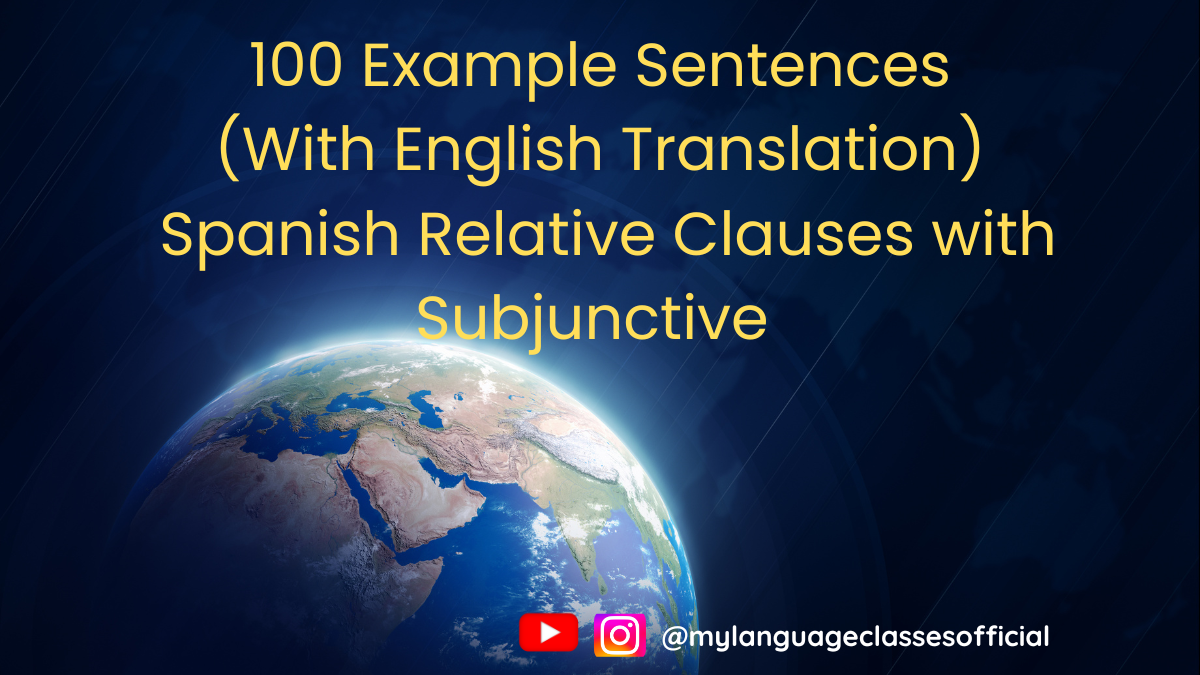
100 Example Sentences of Relative Clauses with Subjunctive in Spanish | My Language Classes
Relative Clauses with Subjunctive
Relative clauses with the subjunctive mood are a powerful tool in Spanish for expressing uncertainty, doubt, or hypothetical situations. They allow you to provide additional information about a noun in a way that feels natural and fluid. Whether you’re a beginner or an advanced learner, practicing example sentences is one of the best ways to master this grammatical structure.
In this blog post, we’ve compiled 100 example sentences of relative clauses with the subjunctive in Spanish to help you understand and practice this concept. Let’s dive in!
100 Example Sentences of Relative Clauses with Subjunctive
- Busco un libro que sea interesante. (I’m looking for a book that is interesting.)
- Necesito un coche que no gaste mucha gasolina. (I need a car that doesn’t use much gas.)
- Quiero un lugar donde pueda relajarme. (I want a place where I can relax.)
- No hay nadie que sepa la respuesta. (There’s no one who knows the answer.)
- Espero encontrar algo que me guste. (I hope to find something that I like.)
- Busco un profesor que hable español. (I’m looking for a teacher who speaks Spanish.)
- No conozco a nadie que haya estado allí. (I don’t know anyone who has been there.)
- Quiero un trabajo que me permita viajar. (I want a job that allows me to travel.)
- Necesito una solución que funcione. (I need a solution that works.)
- Es difícil encontrar a alguien que entienda esto. (It’s hard to find someone who understands this.)
- Busco un hotel que esté cerca de la playa. (I’m looking for a hotel that is near the beach.)
- Quiero un amigo que sea honesto. (I want a friend who is honest.)
- Necesito un teléfono que tenga buena cámara. (I need a phone that has a good camera.)
- No hay ningún restaurante que sirva comida vegana. (There’s no restaurant that serves vegan food.)
- Espero encontrar un lugar que sea tranquilo. (I hope to find a place that is quiet.)
- Busco un vestido que sea elegante. (I’m looking for a dress that is elegant.)
- Quiero un perro que sea cariñoso. (I want a dog that is affectionate.)
- Necesito una computadora que sea rápida. (I need a computer that is fast.)
- No conozco a nadie que haya leído ese libro. (I don’t know anyone who has read that book.)
- Busco un apartamento que tenga balcón. (I’m looking for an apartment that has a balcony.)
- Quiero un coche que sea seguro. (I want a car that is safe.)
- Necesito un médico que hable inglés. (I need a doctor who speaks English.)
- No hay ningún lugar donde pueda estudiar en paz. (There’s no place where I can study in peace.)
- Espero encontrar un trabajo que me haga feliz. (I hope to find a job that makes me happy.)
- Busco un libro que tenga ilustraciones. (I’m looking for a book that has illustrations.)
- Quiero un restaurante que sirva comida picante. (I want a restaurant that serves spicy food.)
- Necesito un parque donde pueda correr. (I need a park where I can run.)
- No hay nadie que pueda ayudarme. (There’s no one who can help me.)
- Busco un amigo que tenga intereses similares. (I’m looking for a friend who has similar interests.)
- Quiero una película que sea emocionante. (I want a movie that is exciting.)
- Necesito un profesor que explique bien. (I need a teacher who explains well.)
- No conozco a nadie que haya visto esa película. (I don’t know anyone who has seen that movie.)
- Busco un lugar donde pueda nadar. (I’m looking for a place where I can swim.)
- Quiero un teléfono que tenga buena batería. (I want a phone that has a good battery.)
- Necesito una silla que sea cómoda. (I need a chair that is comfortable.)
- No hay ningún libro que me interese. (There’s no book that interests me.)
- Espero encontrar un café que tenga buen Wi-Fi. (I hope to find a café that has good Wi-Fi.)
- Busco un coche que sea económico. (I’m looking for a car that is economical.)
- Quiero un trabajo que me permita ser creativo. (I want a job that allows me to be creative.)
- Necesito un lugar donde pueda trabajar en silencio. (I need a place where I can work in silence.)
- No hay nadie que quiera ayudarme. (There’s no one who wants to help me.)
- Busco un restaurante que tenga comida orgánica. (I’m looking for a restaurant that has organic food.)
- Quiero un libro que tenga un final inesperado. (I want a book that has an unexpected ending.)
- Necesito un amigo que me entienda. (I need a friend who understands me.)
- No conozco a nadie que haya estado en Japón. (I don’t know anyone who has been to Japan.)
- Espero encontrar un lugar que sea seguro. (I hope to find a place that is safe.)
- Busco un profesor que sea paciente. (I’m looking for a teacher who is patient.)
- Quiero un coche que tenga aire acondicionado. (I want a car that has air conditioning.)
- Necesito un teléfono que sea resistente al agua. (I need a phone that is waterproof.)
- No hay ningún lugar donde pueda descansar. (There’s no place where I can rest.)
- Busco un apartamento que tenga vista al mar. (I’m looking for an apartment that has a sea view.)
- Quiero un trabajo que me permita trabajar desde casa. (I want a job that allows me to work from home.)
- Necesito un libro que sea fácil de leer. (I need a book that is easy to read.)
- No hay nadie que pueda resolver este problema. (There’s no one who can solve this problem.)
- Espero encontrar un restaurante que tenga opciones vegetarianas. (I hope to find a restaurant that has vegetarian options.)
- Busco un amigo que sea divertido. (I’m looking for a friend who is fun.)
- Quiero un lugar donde pueda pasear a mi perro. (I want a place where I can walk my dog.)
- Necesito un médico que sea comprensivo. (I need a doctor who is understanding.)
- No conozco a nadie que haya escalado esa montaña. (I don’t know anyone who has climbed that mountain.)
- Busco un hotel que tenga piscina. (I’m looking for a hotel that has a pool.)
- Quiero un coche que sea espacioso. (I want a car that is spacious.)
- Necesito un profesor que sea amable. (I need a teacher who is kind.)
- No hay ningún lugar donde pueda bailar. (There’s no place where I can dance.)
- Espero encontrar un libro que me inspire. (I hope to find a book that inspires me.)
- Busco un restaurante que tenga música en vivo. (I’m looking for a restaurant that has live music.)
- Quiero un trabajo que me permita aprender. (I want a job that allows me to learn.)
- Necesito un lugar donde pueda meditar. (I need a place where I can meditate.)
- No hay nadie que pueda explicarme esto. (There’s no one who can explain this to me.)
- Busco un amigo que sea leal. (I’m looking for a friend who is loyal.)
- Quiero un teléfono que tenga buena memoria. (I want a phone that has good memory.)
- Necesito un coche que sea moderno. (I need a car that is modern.)
- No conozco a nadie que haya ganado ese premio. (I don’t know anyone who has won that award.)
- Espero encontrar un lugar que sea acogedor. (I hope to find a place that is cozy.)
- Busco un libro que tenga muchas ilustraciones. (I’m looking for a book that has many illustrations.)
- Quiero un restaurante que tenga terraza. (I want a restaurant that has a terrace.)
- Necesito un profesor que sea divertido. (I need a teacher who is fun.)
- No hay ningún lugar donde pueda pintar. (There’s no place where I can paint.)
- Busco un amigo que sea aventurero. (I’m looking for a friend who is adventurous.)
- Quiero un trabajo que me permita viajar por el mundo. (I want a job that allows me to travel the world.)
- Necesito un lugar donde pueda escribir. (I need a place where I can write.)
- No hay nadie que pueda cantar como tú. (There’s no one who can sing like you.)
- Busco un hotel que tenga gimnasio. (I’m looking for a hotel that has a gym.)
- Quiero un coche que sea ecológico. (I want a car that is eco-friendly.)
- Necesito un libro que tenga un mensaje profundo. (I need a book that has a deep message.)
- No conozco a nadie que haya visto un ovni. (I don’t know anyone who has seen a UFO.)
- Espero encontrar un lugar que sea romántico. (I hope to find a place that is romantic.)
- Busco un profesor que sea inspirador. (I’m looking for a teacher who is inspiring.)
- Quiero un restaurante que tenga comida casera. (I want a restaurant that has homemade food.)
- Necesito un teléfono que sea ligero. (I need a phone that is lightweight.)
- No hay ningún lugar donde pueda hacer yoga. (There’s no place where I can do yoga.)
- Busco un amigo que sea optimista. (I’m looking for a friend who is optimistic.)
- Quiero un trabajo que me permita ayudar a otros. (I want a job that allows me to help others.)
- Necesito un lugar donde pueda leer en paz. (I need a place where I can read in peace.)
- No hay nadie que pueda bailar como ella. (There’s no one who can dance like her.)
- Espero encontrar un libro que me haga reír. (I hope to find a book that makes me laugh.)
- Busco un coche que sea fácil de manejar. (I’m looking for a car that is easy to drive.)
- Quiero un profesor que sea motivador. (I want a teacher who is motivating.)
- Necesito un restaurante que tenga opciones sin gluten. (I need a restaurant that has gluten-free options.)
- No conozco a nadie que haya escrito un libro. (I don’t know anyone who has written a book.)
- Busco un lugar donde pueda ver las estrellas. (I’m looking for a place where I can see the stars.)
Conclusion
Practicing these 100 example sentences of relative clauses with the subjunctive in Spanish will help you become more comfortable with this essential grammar topic. Whether you’re describing hypothetical situations, expressing doubt, or seeking something specific, these sentences provide a solid foundation for mastering the subjunctive mood in relative clauses. Keep practicing, and soon you’ll be using these structures effortlessly in your conversations!
If you found this guide helpful, I’d love to hear from you! Share your thoughts in the comments below or connect with me on social media. For more tips, resources, and inspiration, visit my blog at mylanguageclassesblog.wordpress.com. Follow on Instagram and subscribe on YouTube
-
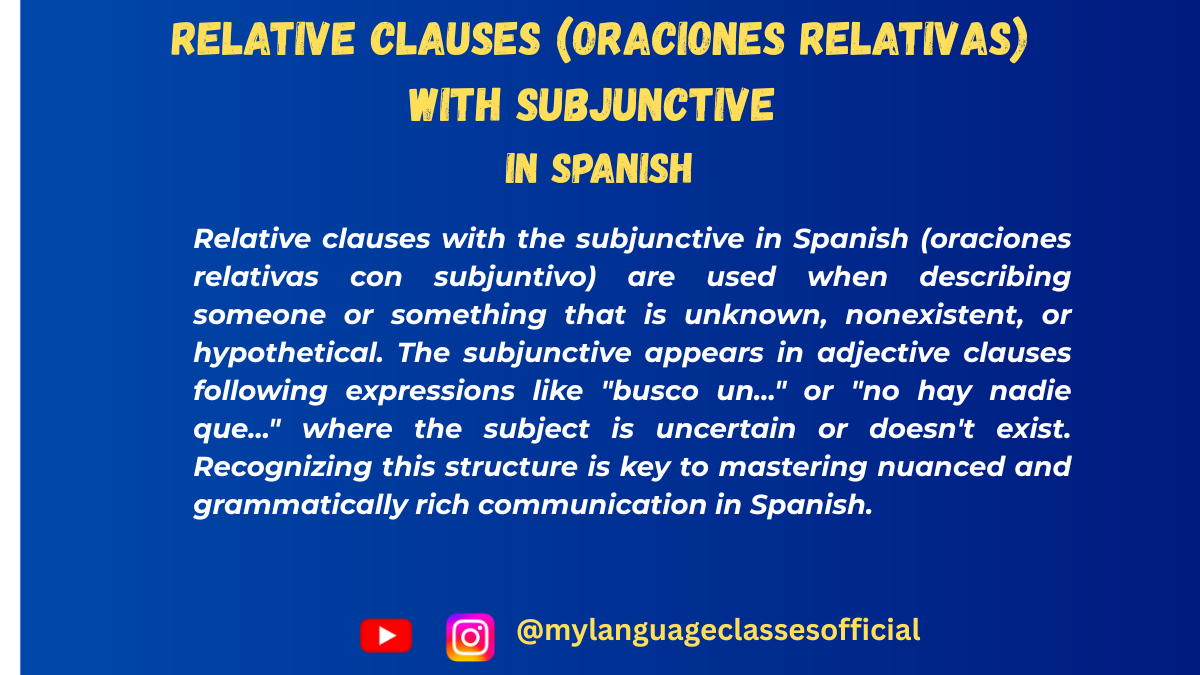
Relative Clauses(oraciones relativas) with Subjunctive in Spanish
Relative clauses, or oraciones relativas, are an essential part of Spanish grammar. They allow us to add extra information about a noun without starting a new sentence. When combined with the subjunctive mood, relative clauses take on a more nuanced meaning, often expressing uncertainty, doubt, or hypothetical situations. Mastering this structure is key to sounding more fluent and natural in Spanish.
In this blog post, we’ll explore everything you need to know about relative clauses with the subjunctive, including common expressions, conjugation rules, and practical examples.
Common Expressions Using Relative Clauses with Subjunctive
Here are some everyday expressions that use relative clauses with the subjunctive. These are frequently used in conversational Spanish:
- Busco a alguien que pueda ayudarme.
(I’m looking for someone who can help me.) - Necesito un libro que sea interesante.
(I need a book that is interesting.) - Quiero un lugar donde pueda relajarme.
(I want a place where I can relax.) - No hay nadie que sepa la respuesta.
(There’s no one who knows the answer.) - Espero encontrar algo que me guste.
(I hope to find something that I like.) - Busco un profesor que hable español.
(I’m looking for a teacher who speaks Spanish.) - No conozco a nadie que haya estado allí.
(I don’t know anyone who has been there.) - Quiero un coche que no gaste mucha gasolina.
(I want a car that doesn’t use much gas.) - Necesito una solución que funcione.
(I need a solution that works.) - Es difícil encontrar a alguien que entienda esto.
(It’s hard to find someone who understands this.)
Things to Keep in Mind
When using relative clauses with the subjunctive, there are a few key points to remember:
- Articles and Agreement: The definite (el, la, los, las) or indefinite (un, una, unos, unas) articles must agree in gender and number with the noun they modify.
Example: Busco una casa que tenga jardín. (I’m looking for a house that has a garden.) - Gender and Plurality: Adjectives and verbs within the relative clause must match the noun in gender and number.
Example: Necesito unos zapatos que sean cómodos. (I need shoes that are comfortable.) - Use of “Que”: The relative pronoun que is the most common connector in these clauses.
Example: Quiero un perro que sea tranquilo. (I want a dog that is calm.) - Indefinite or Non-Specific Nouns: The subjunctive is used when the noun is indefinite or not specific. If the noun is specific, the indicative is used instead.
Example: Subjunctive: Busco un libro que sea bueno. (I’m looking for a book that is good.)
Indicative: Este es el libro que es bueno. (This is the book that is good.) - Expressing Doubt or Uncertainty: The subjunctive is often used to express doubt, uncertainty, or hypothetical situations.
Example: No hay nadie que lo sepa. (There’s no one who knows it.)
When to Use Relative Clauses with Subjunctive
Relative clauses with the subjunctive are used in the following situations:
- When the Antecedent is Unknown or Non-Existent:
Example: Busco un médico que hable inglés. (I’m looking for a doctor who speaks English.) - When Expressing Doubt or Uncertainty:
Example: No creo que haya alguien que pueda hacerlo. (I don’t think there’s anyone who can do it.) - When the Antecedent is Indefinite:
Example: Necesito una casa que tenga tres habitaciones. (I need a house that has three bedrooms.) - When Making Hypothetical Statements:
Example: Quiero un trabajo que me permita viajar. (I want a job that allows me to travel.)
Conjugation of Regular Verbs in Relative Clauses with Subjunctive
To form the subjunctive in relative clauses, follow these steps for regular verbs:
1. -AR Verbs (e.g., hablar):
- yo: hable
- tú: hables
- él/ella/usted: hable
- nosotros/nosotras: hablemos
- vosotros/vosotras: habléis
- ellos/ellas/ustedes: hablen
2. -ER Verbs (e.g., comer):
- yo: coma
- tú: comas
- él/ella/usted: coma
- nosotros/nosotras: comamos
- vosotros/vosotras: comáis
- ellos/ellas/ustedes: coman
3. -IR Verbs (e.g., vivir):
- yo: viva
- tú: vivas
- él/ella/usted: viva
- nosotros/nosotras: vivamos
- vosotros/vosotras: viváis
- ellos/ellas/ustedes: vivan
Irregular Verbs and Their Conjugation
Here are some common irregular verbs in the subjunctive mood:
- Ser (to be):
- yo: sea
- tú: seas
- él/ella/usted: sea
- nosotros/nosotras: seamos
- vosotros/vosotras: seáis
- ellos/ellas/ustedes: sean
- Ir (to go):
- yo: vaya
- tú: vayas
- él/ella/usted: vaya
- nosotros/nosotras: vayamos
- vosotros/vosotras: vayáis
- ellos/ellas/ustedes: vayan
- Tener (to have):
- yo: tenga
- tú: tengas
- él/ella/usted: tenga
- nosotros/nosotras: tengamos
- vosotros/vosotras: tengáis
- ellos/ellas/ustedes: tengan
10 Regular Verbs in Relative Clauses with Subjunctive
Verb Subjunctive Form Example Sentence Meaning Hablar hable Busco alguien que hable francés. I’m looking for someone who speaks French. Comer coma Necesito un restaurante que coma vegano. I need a restaurant that serves vegan food. Vivir viva Quiero un lugar donde viva tranquilo. I want a place where I can live peacefully. Estudiar estudie Busco un profesor que estudie literatura. I’m looking for a teacher who studies lit. Trabajar trabaje Necesito un empleado que trabaje duro. I need an employee who works hard. Escuchar escuche Quiero una canción que escuche relajante. I want a song that sounds relaxing. Escribir escriba Busco un libro que escriba García Márquez. I’m looking for a book written by García Márquez. Leer lea Necesito un artículo que lea interesante. I need an article that reads interesting. Correr corra Quiero un parque donde corra seguro. I want a park where I can run safely. Cocinar cocine Busco un chef que cocine comida mexicana. I’m looking for a chef who cooks Mexican food.
More Example Sentences
- Espero encontrar un hotel que esté cerca de la playa.
(I hope to find a hotel that is near the beach.) - No hay nadie que quiera ayudarme.
(There’s no one who wants to help me.) - Quiero un vestido que sea elegante.
(I want a dress that is elegant.) - Busco un amigo que tenga intereses similares.
(I’m looking for a friend who has similar interests.) - Necesito un teléfono que funcione bien.
(I need a phone that works well.) - No conozco a nadie que haya viajado allí.
(I don’t know anyone who has traveled there.) - Quiero un trabajo que me permita ser creativo.
(I want a job that allows me to be creative.) - Es difícil encontrar un lugar que sea perfecto.
(It’s hard to find a place that is perfect.) - Busco una película que sea emocionante.
(I’m looking for a movie that is exciting.) - Necesito una solución que resuelva el problema.
(I need a solution that solves the problem.)
Fill in the Blanks
- Busco un libro que _____ (ser) interesante.
- Necesito un coche que no _____ (gastar) mucha gasolina.
- Quiero un lugar donde _____ (poder) relajarme.
- No hay nadie que _____ (saber) la respuesta.
- Espero encontrar algo que me _____ (gustar).
- Busco un profesor que _____ (hablar) español.
- No conozco a nadie que _____ (haber) estado allí.
- Quiero un trabajo que me _____ (permitir) viajar.
- Necesito una solución que _____ (funcionar).
- Es difícil encontrar a alguien que _____ (entender) esto.
Answers:
- sea
- gaste
- pueda
- sepa
- guste
- hable
- haya
- permita
- funcione
- entienda
Conclusion
Mastering relative clauses with the subjunctive in Spanish opens up a world of expressive possibilities. Whether you’re describing hypothetical situations, expressing doubt, or seeking something specific, this grammatical structure is indispensable. By practicing the conjugations, memorizing common expressions, and understanding the nuances, you’ll be well on your way to sounding like a native speaker. Keep practicing, and soon you’ll be using relative clauses with the subjunctive effortlessly in your conversations!
If you enjoyed this lesson, be sure to check out more posts like this on my blog at My Language Classes. Don’t forget to subscribe my YouTube channel and follow me on Instagram for the latest language learning tips and lessons. Leave a comment below to share your thoughts, or ask any questions you have about nouns.
Happy learning! 😊
- 100 Spanish Example Sentences
- 100 Spanish Fill-in-the-Blanks Exercises
- 100 Spanish Vocabulary Lists
- Spanish – Advanced
- Spanish – Beginner
- Spanish – Intermediate
- Busco a alguien que pueda ayudarme.

